
Chapter 16
Where Does the Ice Age Fit?
The ice age is a popular topic that is often discussed. Sadly, most people hear the secular/uniformitarian view and don’t look at this subject from a biblical perspective.
If you ask a youngster the question, “Was there really an ice age?” they might say rather quickly that there was. Then they may tell you that there were two of them. Of course, if you listen much longer, they will tell you that they saw both of those movies in the theater.
The ice age is a popular topic that is often discussed in school, at home, or in Hollywood. Sadly, most people hear the secular/uniformitarian view and don’t look at this subject from a biblical perspective. This is where it gets interesting, though. The secular view has no good mechanism to cause a single ice age, let alone the many they propose. But the Bible does have a mechanism. Let’s take a closer look.
Before I get too deep, let me define a few words you’ll need to know to help clarify this chapter:

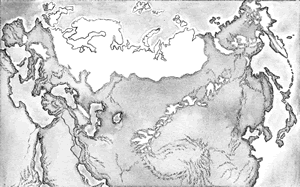
Figures 1 and 2. The extent of the Ice Age over North America and Eurasia.
Glacier: a large mass of ice that has accumulated from snow over the years and is slowly moving from a higher place.
Moraines: stones, boulders, and debris that have been carried and dropped by a glacier.
Uniformitarianism: the belief that rates today are the same as they were in the past, without the possibility of major catastrophes like worldwide floods.
Interglacial: a short period of warming between glacier growth/movement that caused glaciers to melt away.
Ice cores: cores of ice that have been drilled down into a glacier.
Ice Age: when seen in capital letters, refers to the biblical post-Flood Ice Age.
An ice age is defined as a time of extensive glacial activity in which substantially more of the land is covered by ice. During the Ice Age that ended several thousand years ago, 30 percent of the land surface of the earth was covered by ice (Figures 1 and 2). In North America an ice sheet covered almost all of Canada and the northern United States.
We know the extent of the Ice Age in the recent past because similar features, as observed around glaciers today, are also found in formerly glaciated areas, such as lateral and terminal moraines. A lateral moraine is a mound of rocks of all sizes deposited on the side of a moving glacier, while a terminal, or end, moraine is a mound of rocks bulldozed in front of the glacier.
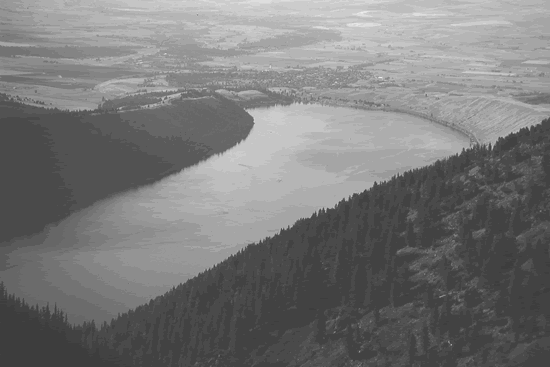
Figure 3. Horseshoe-shaped lateral and end moraines plowed up by a glacier moving out of a valley in the northern Wallowa Mountains of northeast Oregon. Beautiful Wallowa Lake fills the depression within the moraines.
Figure 3 shows a horseshoe-shaped moraine from a glacier that spread out from a valley in the Wallowa Mountains of northeast Oregon. The two lateral moraines are 600 feet (183 m) high, while the end moraine is 100 feet (30 m) high, enclosing beautiful Wallowa Lake. Scratched bedrock and boulders are telltale signs of previous glaciation (Figures 4 and 5), which are similar to such features found around glaciers today (Figures 6 and 7).

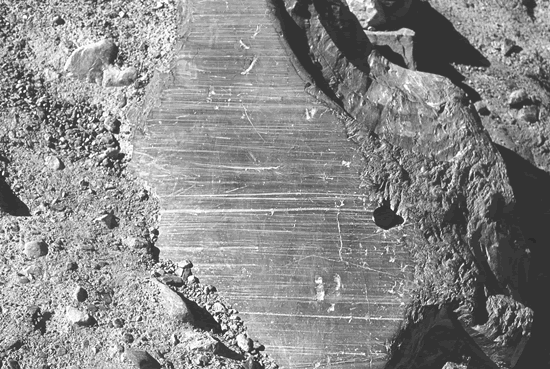
Figures 4 and 5. Striated bedrock and boulders from an ice cap in the northern Rocky Mountains that spread through the Sun River Canyon out onto the high plains, west of Great Falls, Montana.

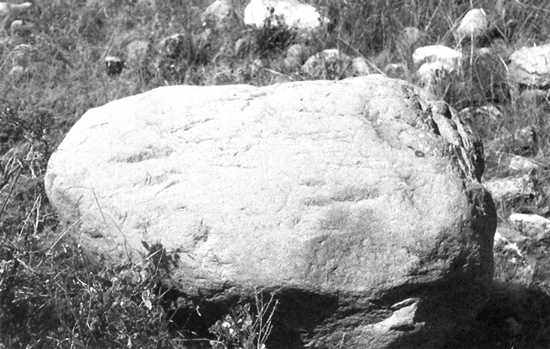
Figures 6 and 7. Scratched bedrock and boulder from the Athabasca Glacier in the Canadian Rocky Mountains.
Secular/Uniformitarian Belief
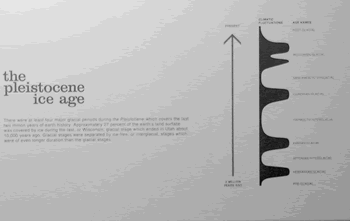
Figure 8. Display of four ice ages at the College of Eastern Utah Prehistoric Museum at Price, Utah, taken in 2006.
Secular/uniformitarian scientists used to believe that there were four ice ages during the past few million years. However, the idea of four ice ages was rejected in the 1970s in favor of thirty or more ice ages separated by interglacials.1 Such a switch was forced by a paradigm change in glaciology toward belief in the astronomical model of the ice ages (or “Milankovitch mechanism,” as it is called). The idea of four ice ages still lingers in public museum displays, though (Figure 8).
The astronomical model postulates regularly repeating ice ages caused by the changing orbital geometry of the earth. Secular glaciologists believe that over the past 800,000 years there were, allegedly, eight ice ages, each lasting about 100,000 years.2 The glacial phase supposedly dominated for 90,000 years, while the interglacial phase lasted only 10,000 years. Accordingly, the story continues that beyond 800,000 years, the ice ages are believed to have cycled every 40,000 years or so.
The secular/uniformitarian model now holds that the Antarctic Ice Sheet developed around 40 million years ago and reached general equilibrium about 15 million years ago.3 The Greenland Ice Sheet, they say, is younger, having developed only a few million years ago.
Uniformitarian scientists further believe four “ancient ice ages” occurred during geological time (Table 1). These ice ages supposedly occurred hundreds of millions to several billion years ago, with each ice age lasting tens to hundreds of millions of years. Ancient ice ages are deduced from features in the rock that seem to indicate glaciation.
| Geological Period | Secular Approximate Age Range (million years ago) |
|---|---|
| Late Paleozoic | 256–338 |
| Late Ordovician | 429–445 |
| Late Proterozoic | 520–950 |
| Early Proterozoic | 2200–2400 |
| Table 1. The four main “ancient ice ages” within the uniformitarian paradigm and their inferred age range in millions of years before the present. The age ranges for the earliest “ice ages” are admittedly rough estimates.4 | |
Severe Difficulties with Secular/Uniformitarian Beliefs
Secular/uniformitarian scientists have great difficulty explaining any recent ice ages based on rates they observe today. They have proposed dozens of hypotheses, but all have serious flaws. One problem is that the summer temperatures in the northern United States would have to cool more than 50°F (28°C) accompanied by a huge increase in snow. What would trigger or sustain such a dramatic climate change that would persist for thousands of years? David Alt of the University of Montana in Missoula recently admitted, “Although theories abound, no one really knows what causes ice ages.”5
Ancient ice ages have been somewhat controversial over the years, but recently some uniformitarian scientists have come out with the shocking belief that some Proterozoic ice ages were global.6 This belief is based on paleomagnetic data that supposedly shows certain rocks, believed to be from ancient ice ages, were marine and equatorial. Because of the reflection of sunlight from a white surface, it is likely that a glaciated earth would never melt. However, advocates of “snowball earth” state not only that such a glaciation completely melted but also that temperatures following glaciation ended up much warmer than today. Such a “freeze-fry” hypothesis indicates that the concept of ancient ice ages is unsound.
Did the Flood Trigger the Ice Age?
If uniformitarian scientists have severe difficulties accounting for ice ages, how would creationists explain an ice age or multiple ice ages? Let’s start with the recent ice age.
When attempting to account for ice ages, the uniformitarian scientists do not consider one key element—the Genesis Flood. What if there truly were a worldwide Flood? How would it have affected the climate? A worldwide Flood would have caused major changes in the earth’s crust, as well as earth movements and tremendous volcanism. It would have also greatly disturbed the climate.
A shroud of volcanic dust and aerosols (very small particles) would have been trapped in the stratosphere for several years following the Flood. These volcanic effluents would have then reflected some of the sunlight back to space and caused cooler summers, mainly over large landmasses of the mid and high latitudes. Volcanoes would have also been active during the Ice Age and gradually declined as the earth settled down. Abundant evidence shows substantial Ice Age volcanism, which would have replenished the dust and aerosols in the stratosphere.7 The Greenland and Antarctic ice sheets also show abundant volcanic particles and acids in the Ice Age portion of the ice cores.8
An ice age also requires huge amounts of precipitation. The Genesis account records the “fountains of the great deep” bursting forth during the Flood. Crustal movements would have released hot water from the earth’s crust along with volcanism and large underwater lava flows, which would have added heat to the ocean. Earth movement and rapid Flood currents would have then mixed the warm water, so that after the Flood the oceans would be warm from pole to pole. There would be no sea ice. A warm ocean would have had much higher evaporation than the present cool ocean surface. Most of this evaporation would have occurred at mid and high latitudes, close to the developing ice sheets, dropping the moisture on the cold continent. This is a recipe for powerful and continuous snowstorms that can be estimated using basic meteorology.9 Therefore, to cause an ice age, rare conditions are required—warm oceans for high precipitation, and cool summers for lack of melting the snow. Only then can it accumulate into an ice sheet.
The principles of atmospheric science can also estimate areas of high oceanic evaporation, the eventual depth of the ice, and even the timing of the Ice Age. Numerical simulations of precipitation in the polar regions using conventional climate models with warm sea surface temperatures have demonstrated that ice sheets thousands of feet thick could have accumulated in less than 500 years.10
A Rapid Ice Age
Most creationists agree that there was one major Ice Age following the Flood. The timing of the Ice Age is quite significant, since uniformitarians claim that each ice age over the past 800,000 years lasted about 100,000 years. To estimate the time for a post-Flood Ice Age, we need to know how long the volcanism lasted and the cooling time of the oceans. Once these two mechanisms for the Ice Age wane, the ice sheets will reach a maximum and then begin to melt. So, an estimate of the time for the Ice Age can be worked out based on the available moisture for snow and the cooling time of the ocean (the primary mechanism) in a cool post-Flood climate.
I used budget equations for the cooling of the ocean and atmosphere, which are simply based on heat inputs minus heat outputs—the difference causing the change in temperatures. Since there is no way to be precise, I used minimums and maximums for the variables in the equations in order to bracket the time. The best estimate is about 500 years after the Flood to reach glacial maximum with an average ice and snow depth of about 2,300 feet (700 m) in the Northern Hemisphere and 4,000 feet (1,220 m) on Antarctica.11
Once the conditions for the Ice Age ended, those ice sheets in unfavorable areas melted rapidly. Antarctica and Greenland, possessing a favorable latitude and altitude, would continue to grow during deglaciation and afterward. To calculate the melting rate for the ice sheets over North America and Eurasia, I used the energy balance over a snow cover, which gives a faster rate than the uniformitarians propose based on their models.
An energy balance equation is a straightforward and more physical method of calculating the melt rate. Using maximum and minimum values for the variable in the melt equation, I obtained a best estimate of the average melt rate along the periphery (a 400-mile [645-km] long strip) of the ice sheet in North America at about 33 feet/year (10 m/year). Such a melting rate compares favorably with current melt rates for the melting zones of Alaskan, Icelandic, and Norwegian glaciers today. At this rate, the periphery of the ice sheets melts in less than 100 years. Interior areas of ice sheets would melt more slowly, but the ice would be gone in about 200 years. The ice sheets melt so fast, catastrophic flooding would be expected, such as with the bursting of glacial Lake Missoula described later in this chapter.
Therefore, the total length of time for a post-Flood Ice Age is about 700 years. It was indeed a rapid Ice Age. This is an example of bringing back the Flood into earth history. As a result, processes that seem too slow at today’s rates were much faster in the past. The Flood was never disproved; it was arbitrarily rejected in the 1700s and 1800s by secular intellectuals in favor of slow processes over millions of years.
How Many Ice Ages?
Still, there is the claim of many ice ages. Most formerly glaciated areas show evidence for only one ice age, and a substantial amount of information indicates only one ice age.12 The idea of multiple ice ages is essentially a uniformitarian assumption. Today this idea is strongly based on oxygen isotope ratios from seafloor sediments. The paleothermometers developed from these data assume highly questionable statistical comparisons between peaks and valleys in temperature, which are claimed to correspond to orbital changes in the heating of the earth. In a provocative paper concluding that only one ice sheet covered southern and central Alberta late in the uniformitarian timescale, Robert Young and others stated: “Glacial reconstructions commonly assume a multiple-glaciation hypothesis in all areas that contain a till cover.”13
Areas that appear to have evidence of more than one ice age can be reinterpreted to be the deposits from one ice sheet that advanced and retreated over a short period. The more modern understanding of glacial activity indicates that ice sheets are very dynamic. We do not need 100,000 years for each ice age or 2.5 million years for multiple ice ages.
One of the key assumptions in the multiple glaciation hypothesis is the astronomical model of ice ages. This mechanism is based on cyclical past changes in the geometry of the earth’s orbit. Uniformitarian scientists believe that a decrease in solar radiation at about 60° N in summer, resulting from orbital changes, causes repeating ice ages, either every 100,000 years or every 40,000 years. By matching wiggles in variables taken from deep-sea cores, uniformitarian scientists believe they have proven the astronomical mechanism of multiple ice ages.14 There are many problems with this model and relating deep-sea cores to it; mainly, the decrease in sunshine is too small.15 Didier Paillard stated,
Nevertheless, several problems in classical astronomical theory of paleoclimate have indeed been identified: (1) The main cyclicity in the paleoclimate record is close to 100,000 years, but there is [sic] no significant orbitally induced changes in the radiative [sunshine] forcing of the Earth in this frequency range (the “100-kyr Problem”).16
Although the main cycle in the astronomical model is 100,000 years, the change in sunshine at high northern latitudes is insignificant for such a dramatic change as an ice age.
Is the Ice Age Biblical?
Since the Flood offers a viable explanation for the Ice Age, one could expect that the Ice Age would be mentioned in the Bible. It is possible that the book of Job, written about 500 years or so after the Flood, may include a reference to the Ice Age in Job 38:29–30, which says, “From whose womb comes the ice? And the frost of heaven, who gives it birth? The waters harden like stone, and the surface of the deep is frozen.” However, Job could have observed frost and lake ice during winter in Palestine, especially if temperatures were colder because of the Ice Age. The reason the Ice Age is not directly discussed in the Bible is probably because the Scandinavian ice sheet and mountain ice caps were farther north than the region where the Bible was written. Only an increase in the snow coverage of Mt. Hermon and possibly more frequent snowfalls on the high areas of the Middle East would have been evident to those living in Palestine.
How Are “Ancient Ice Ages” Explained?
The evidence for “ancient ice ages” is found in the hard rocks; these deposits are not on the surface like the deposits from the post-Flood Ice Age. There are substantial difficulties in interpreting these rocks as from ancient ice ages.17 An alternative mechanism can easily explain these deposits within a biblical framework. This mechanism is gigantic submarine landslides that occurred during the Genesis Flood.
The Mystery of the Woolly Mammoths
Millions of woolly mammoth bones, tusks, and a few carcasses have been found frozen in the surface sediments of Siberia, Alaska, and the Yukon Territory of Canada—a major mystery of uniformitarian paleoclimate. The woolly mammoths were part of a Northern Hemisphere community of animals that lived and died during the post-Flood Ice Age.18 Woolly mammoths probably died after the Flood because there are thousands of carcasses scattered across Alaska and Siberia resting above Flood deposits. And there must have been sufficient time for the mammoths to have repopulated these regions after the Flood. The post-Flood Ice Age provides an explanation for the mystery of the woolly mammoths, as well as many other Ice Age mysteries.

Figure 9. Large dust drift to the top of a house during the dust bowl era in the Midwest.
The mammoths spread into these northern areas during early and middle Ice Age time because summers were cooler and winters warmer. The areas were unglaciated (just the mountains glaciated) and a rich grassland. However, late in the Ice Age, winter temperatures turned colder and the climate drier with strong wind storms. The mammoths died by the millions and were buried by dust, which later froze, preserving the mammoths. Severe dust storms that produce tall dust drifts (Figure 9) can also explain a number of the secondary mysteries, such as some carcasses that show evidence of suffocation in a generally standing position, and how they become entombed into rock-hard permafrost (for a more complete treatment of this subject, please see my book, Frozen in Time).
Is Glacial Lake Missoula Related to the Ice Age?
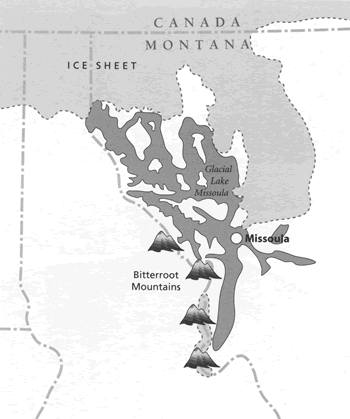
Figure 10. Map of ice sheet and glacial Lake Missoula (drawn by Mark Wolfe)
At the peak of the Ice Age, a finger of the ice sheet in western Canada and the northwest United States filled up the valleys of northern Idaho. A huge lake 2,000 feet (610 m) deep was formed in the valleys of western Montana. This was glacial Lake Missoula (Figure 10). In the course of time, the lake burst and emptied in a few days, causing an immense flood several hundred feet deep that carved out canyons and produced many flood features from eastern Washington into northwest Oregon (Figure 11).
This flood can help us understand the global Flood. Interestingly, the Lake Missoula flood was rejected for 40 years despite tremendous evidence because of the anti-biblical bias in historical science.19
Now this flood is not only accepted, but uniformitarian scientists now believe many more of them occurred. They postulate 40 to 100 at the peak of their last ice age, with perhaps hundreds more from previous ice ages. However, the evidence is substantial that there was only one gigantic Lake Missoula flood, with possibly several minor floods afterward.20
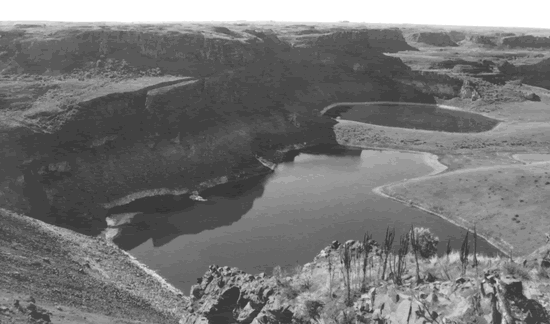
Figure 11. The Potholes, remnants of a 400-foot (120 m) high waterfall. The lakes at the bottom are remnant plunge pools.
What about Ice Cores?
Uniformitarian scientists claim to be able to count annual layers in the Greenland ice sheet to determine its age, in the same way people can count tree rings. In doing so, they arrive at 110,000 years near the bottom of the Greenland ice sheet. Similar claims for a much greater age are made for the Antarctica ice sheet. These claims are equivocal and are essentially based on the uniformitarian belief that the ice sheets are millions of years old. The data from ice cores can be better explained within the post-Flood Ice Age model, which dramatically reduces the calculated age to well within the biblical limit.21
Conclusion
Although a major mystery of uniformitarian history, the Ice Age is readily explained by the climatic consequences of the Genesis Flood—it was a short Ice Age of about 700 years, and there was only one Ice Age.22 We do not need the hundred thousand years for one ice age, or the few million years for multiple ice ages, as claimed by uniformitarian scientists.
Even their claim of ancient ice ages in the hard rocks can be accounted for by gigantic submarine landslides during the Flood. The post-Flood rapid Ice Age can also account for a number of major mysteries and other interesting phenomena that occurred during the Ice Age, such as the Lake Missoula flood and the life and death of the woolly mammoths in Siberia and elsewhere. When we stick to the Genesis account of the Flood and the short scriptural timescale, major secular/uniformitarian mysteries are readily explained.23
The New Answers Book 1
The New Answers Book 1 is packed with biblical answers to over 25 of the most important questions on creation,evolution, and the Bible.
Read Online Buy BookFootnotes
- J. Kennett, Marine Geology, Prentice-Hall, Englewood Cliffs, New Jersey, 1982, 747.
- D. Paillard, Glacial cycles: toward a new paradigm, Reviews of Geophysics, 39(3):325–346, 2001.
- M.J. Oard, The Frozen Record: Examining the Ice Core History of the Greenland and Antarctic Ice Sheets, Institute for Creation Research, El Cajon, California, 2005, 31–34.
- J.C. Crowell, Pre-Mesozoic Ice Ages: Their Bearing on Understanding the Climate System, Geological Society of America Memoir 192, Boulder, Colorado, 1999, 3.
- D. Alt, Glacial Lake Missoula and its Humongous Floods, Mountain Press Publishing Company, Missoula, Montana, 2001, 180.
- M.J. Oard, Another tropical ice age? Journal of Creation 11(3):259–261, 1997; M.J. Oard, Snowball Earth—a problem for the supposed origin of multicellular animals, Journal of Creation 16(1):6–9, 2002.
- M.J. Oard, An Ice Age Caused by the Genesis Flood, Institute for Creation Research, El Cajon, California, 1990, 33–38.
- Oard, The Frozen Record.
- Oard, An Ice Age Caused by the Genesis Flood.
- L. Vardiman, Climates before and after the Genesis Flood: numerical models and their implications, Institute for Creation Research, El Cajon, California, 2001.
- Oard, An Ice Age Caused by the Genesis Flood.
- Ibid., 135–166.
- R.R. Young et. al., A single, late Wisconsin, Laurentide glaciation, Edmonton area and southwestern Alberta, Geology 22:683–686, 1994.
- J.D. Hays, J. Imbrie, and N.J. Shackleton, Variations in the earth’s orbit: pacemaker of the ice ages, Science 194:1121–1132, 1976.
- Oard, The Frozen Record, 111–122.
- Paillard, Glacial cycles: toward a new paradigm, 325.
- M.J. Oard, Ancient Ice Ages or Gigantic Submarine Landslides? Creation Research Society Monograph No. 6, Chino Valley, Arizona, 1997.
- M.J. Oard, Frozen In Time: The Woolly Mammoths, the Ice Age, and the Bible, Master Books, Green Forest, Arkansas, 2004.
- M.J. Oard, The Missoula Flood Controversy and the Genesis Flood, Creation Research Society Monograph No. 13, Chino Valley, AZ, 2004.
- Ibid.
- L. Vardiman, Ice cores and the Age of the Earth, Institute for Creation Research, El Cajon, California, 1993; Oard, The Frozen Record.
- Oard, An Ice Age Caused by the Genesis Flood; Oard, Ancient Ice Ages or Gigantic Submarine Landslides? M.J. Oard and B. Oard, Life in the Great Ice Age, Master Books, Green Forest, Arkansas, 1993.
- For more on the Ice Age, see www.answersingenesis.org/go/ice-age.

Answers in Genesis is an apologetics ministry, dedicated to helping Christians defend their faith and proclaim the good news of Jesus Christ.
- Customer Service 800.778.3390
- Available Monday–Friday | 9 AM–5 PM ET
- © 2026 Answers in Genesis

